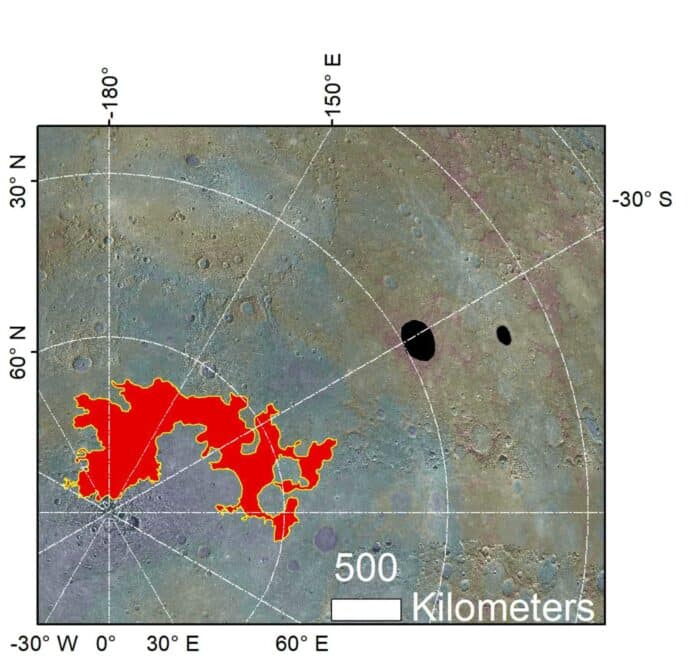Due to Mercury’s closeness to the Sun and high surface temperatures, scientists had assumed Mercury’s crust to be predominantly devoid of volatile compounds. The discovery of volatile-rich surfaces on Mercury dramatically altered this view of the planet. The volatile-rich surface includes high sulfur, chlorine, sodium, and potassium abundances.
Now, scientists from the Planetary Science Institute have uncovered evidence of potential salt glaciers on Mercury. The study reveals a volatile environment that may resemble the habitability conditions observed in Earth’s most remote locations, opening a new chapter in the study of astrobiology.
The discovery supports other recent studies demonstrating Pluto has nitrogen glaciers, suggesting glaciation occurs across our solar system, from the warmest to the coldest regions. These places are crucial because they pinpoint volatile-rich exposures spread throughout the immensity of many planetary environments.
These Mercurian glaciers are different from that of Earth. They originated from deeply buried Volatile Rich Layers (VRLs) exposed by asteroid impacts.
Co-author Travis said, “Our models strongly affirm that salt flow likely produced these glaciers and that after their emplacement, they retained volatiles for over 1 billion years.”
Alexis Rodriguez, lead author of the paper, said, “Specific salt compounds on Earth create habitable niches even in some of the harshest environments where they occur, such as the arid Atacama Desert in Chile. This thinking leads us to ponder the possibility of subsurface areas on Mercury that might be more hospitable than its harsh surface. These areas could act as depth-dependent ‘Goldilocks zones,’ analogous to the region around a star where the existence of liquid water on a planet might enable life as we know it. Still, in this case, the focus is on the right depth below the planet’s surface rather than the right distance from a star.”
“This groundbreaking discovery of Mercurian glaciers extends our comprehension of the environmental parameters that could sustain life, adding a vital dimension to our exploration of astrobiology also relevant to the potential habitability of Mercury-like exoplanets.”
The finding strengthens our knowledge of VRLs, which may be buried far below Mercury’s surface, and casts doubt on the long-held belief that the planet is essentially free of volatile substances.
An intricate arrangement of hollows that generate extensive (and highly young) sublimation pits is a distinguishing feature of Mercury’s glaciers. These voids have depths that make up a large fraction of the total thickness of the glacier, suggesting that their bulk composition is rich in volatiles.
The walls and floors of the neighboring craters noticeably lack these hollows. This finding offers a logical explanation for a previously puzzling phenomenon: the relationship between crater interiors and hollows. The suggested remedy suggests that groups of hollows in impact craters could result from impact-induced zones of VRL exposures, explaining a relationship that has long puzzled planetary scientists.
Rodriguez said, “A central mystery concerning Mercury revolves around the genesis of its glaciers and chaotic terrains. What mechanism was responsible for the formation of VRLs? Our research introduces a model that integrates recent observational data to address this question. Notably, we examine the Borealis Chaos in Mercury’s north polar region. This area is characterized by intricate patterns of disintegration, significant enough to have obliterated entire populations of craters, some dating back approximately 4 billion years.”
“Beneath this collapsed layer lies an even more ancient, cratered paleo-surface, previously identified through gravity studies. The juxtaposition of the fragmented upper crust, now forming chaotic terrain, over this gravity-revealed ancient surface suggests that the VRLs were emplaced atop an already solidified landscape.”
“These findings challenge prevailing theories of VRL formation that traditionally centered on mantle differentiation processes, where minerals separate into different layers within the planet’s interior. Instead, the evidence suggests a grand-scale structure, possibly stemming from the collapse of a fleeting, hot primordial atmosphere early in Mercury’s history. This atmospheric collapse might have occurred mostly during the extended nighttime periods when the planet’s surface was not exposed to the Sun’s intense heat.”
PSI scientist Jeffrey S. Kargel said, “Underwater deposition could have significantly contributed to the emplacement of a salt-dominated Mercurian VRL, marking a significant departure from previous theories about the planet’s early geological history.”
“In this scenario, water released through volcanic degassing may have temporarily created pools or shallow seas of liquid or supercritical water (like a dense, highly salty steam), allowing salt deposits to settle. Subsequent rapid loss of water into space and trapping of water in hydrated minerals in the crust would have left behind a salt- and clay mineral-dominated layer, which progressively built up into thick deposits.”
Journal Reference:
- J. Alexis P. Rodriguez, Deborah Domingue, Bryan Travis, Jeffrey S. Kargel et al. Mercury’s Hidden Past: Revealing a Volatile-dominated Layer through Glacier-like Features and Chaotic Terrains. The Planetary Science Journal. DOI: 10.3847/PSJ/acf219
